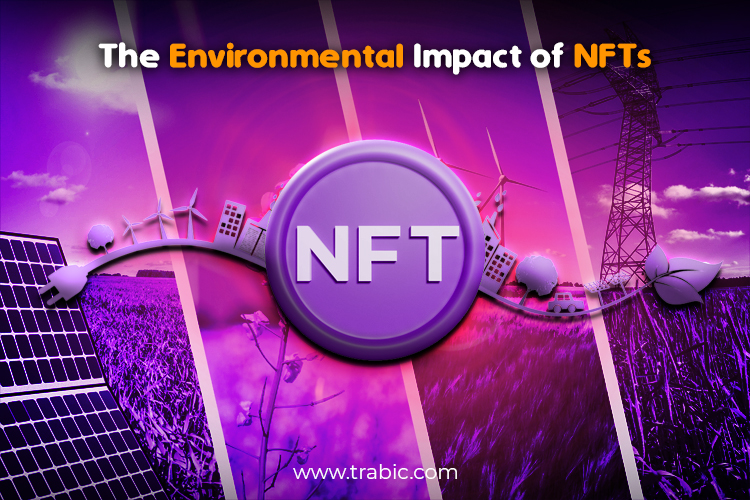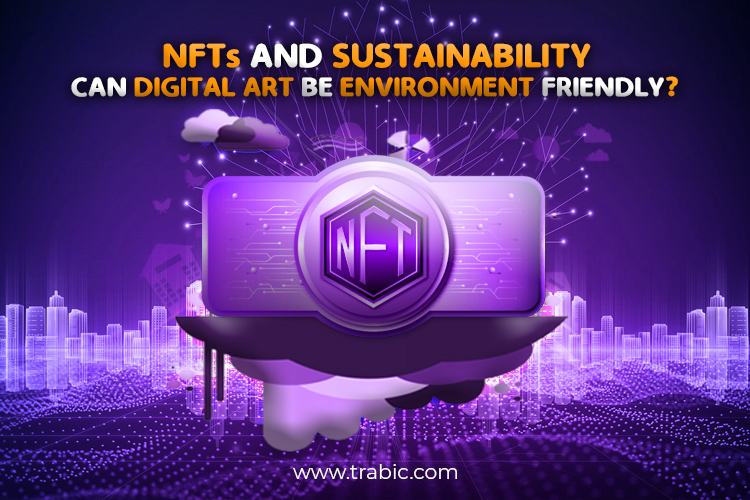marNon-Fungible Tokens (NFTs), the latest craze in the art world, have ignited a fiery debate surrounding their environmental impact. As we excavate into the depths of this captivating topic, we find ourselves pondering the intriguing question: Can digital art truly be environmentally friendly?
One must first grasp their essence to comprehend the environmental implications of NFTs. They serve as verifiable certificates of ownership for unique digital assets, primarily artwork. They harness blockchain technology, ensuring these digital creations’ transparency, immutability, and scarcity. However, their association with the energy-intensive cryptocurrency mining process has raised sustainability concerns.
When examining the environmental ramifications of Non-Fungible Tokens, it is crucial to scrutinize the primary culprit: blockchain’s carbon footprint. Blockchain networks like Ethereum rely on the energy-intensive consensus mechanism known as Proof of Work. This algorithm necessitates numerous computers, or miners, competing to solve complex mathematical puzzles, resulting in excessive electricity consumption. Consequently, the carbon emissions produced during this process have raised alarm bells among environmental advocates.
Nevertheless, it is imperative to approach this issue with a discerning eye. While it is true that Non-Fungible Tokens are currently associated with energy-intensive blockchains, the situation is still possible. Technological advancements, like the anticipated transition from PoW to Proof of Stake (PoS), offer promising solutions. PoS algorithms require validators to hold a certain amount of cryptocurrency, eliminating the need for extensive computational power. By embracing these greener alternatives, the carbon footprint of blockchain systems can be significantly reduced, paving the way for a more sustainable digital art market.
Furthermore, it is crucial to acknowledge the potential for Non-Fungible Tokens to catalyze positive change in sustainability. Digital art possesses inherent ecological advantages over traditional art forms. The production and distribution of physical artwork entail substantial resources, from raw materials to transportation, leaving an indelible ecological footprint. Conversely, digital art exists purely in the virtual realm, eliminating the need for physical materials and reducing carbon emissions associated with logistics.
In addition to their inherent eco-friendliness, NFTs have the potential to empower artists to contribute actively to environmental causes. With each transaction, artists can embed royalties within the smart contracts governing Non-Fungible Tokens, ensuring a continuous revenue stream for themselves. Consequently, artists can allocate some of these proceeds to support environmental initiatives, thereby tangibly contributing to the conflict against environmental degradation and climate change.
The rise of Non-Fungible Tokens (NFTs) has brought a new dimension to the digital art world. NFTs are unique digital assets using blockchain technology to verify ownership and ensure authenticity. While Non-Fungible Tokens provide a new way for artists to monetize their work and give buyers a sense of ownership and exclusivity, concerns have arisen about the environmental impact of this new market.
The process of producing and trading Non-Fungible Tokens requires significant computational power, which in turn results in a large carbon footprint. As the world wrestles with the challenges of climate change, it is vital to question whether digital art can be environmentally friendly. This post explores the relationship between NFTs and sustainability and delves into solutions to make the NFT market more eco-friendly.
From understanding the environmental impact of NFTs to exploring sustainable solutions, this post comprehensively analyzes the relationship between Non-Fungible Tokens and sustainability and the potential for a more sustainable future for digital art.
What Are NFTs, And Why Are They Famous?

NFTs, or Non-Fungible Tokens, are unique digital assets representing ownership of a specific piece of content, such as artwork, music, or video. Non-Fungible Tokens are held on a blockchain, which is a decentralized digital ledger that delivers a secure and transparent way of verifying ownership and authenticity. One of the fundamental reasons for the NFT’s popularity is the ability of artists to monetize their digital creations.
Before the rise of NFTs, digital art was often difficult to sell, as it was quickly copied and shared online. However, Non-Fungible Tokens deliver a path for artists to create one-of-a-kind digital assets verified on the blockchain, which can be purchased and marketed like traditional artwork.
Non-Fungible Tokens also give buyers a sense of ownership and exclusivity in the digital world. By owning an NFT, buyers have proof of ownership and can verify the authenticity of the digital asset. This is particularly attractive for collectors, who value unique and rare pieces of artwork. The popularity of NFTs has also been fueled by their utilization in other industries, such as sports and gaming. For example, NBA Top Shot is an NFT platform that allows fans to own unique digital collectibles of their favorite basketball players.
Similarly, gaming companies use NFTs to produce unique in-game items that can be purchased and marketed on the blockchain. Non-Fungible Tokens are popular because they provide a unique method for artists to monetize their digital developments and give buyers a sense of ownership and exclusivity in the digital world. With the boost in the usage of blockchain technology and the increasing demand for digital assets, NFTs will likely continue to grow in popularity in the coming years.
The Environmental Impact Of NFTs
The environmental impact of NFTs stems from the large amount of energy required to create and trade them. Non-Fungible Tokens are created using blockchain technology, which involves a complex cryptographic process requiring significant computational power. The energy consumption of blockchain technology is primarily driven by mining, which involves solving complex mathematical problems to validate transactions on the blockchain.
This process requires specialized hardware, such as ASICs (Application-Specific Integrated Circuits) or GPUs (Graphics Processing Units), which consume much electricity. As per some recent studies, the carbon footprint of a single NFT transaction can be equivalent to a month’s worth of electricity consumption for an average household. The energy utilization of the Ethereum blockchain, the most famous blockchain platform for producing and trading NFTs, is estimated to be identical to that of a small country.
Moreover, most electricity used to power blockchain mining comes from fossil fuel-originated sources, such as coal and natural gas. This means that the creation and trading of NFTs contribute to greenhouse gas emissions and exacerbate the effects of climate change. The environmental impact of Non-Fungible Tokens is also compounded by the fact that they often involve the transfer of large digital files, which require significant storage and data center resources.
Data centers use a large amount of electricity to power their servers and cooling systems, and the demand for data storage and transfer is expected to grow as the NFT market expands. The environmental impact of Non-Fungible Tokens is significant, and it is vital to address these concerns as the market for NFTs continues to grow.

While blockchain technology delivers a secure and transparent way to testify to the ownership and authenticity of digital assets, the energy consumption required to create and trade NFTs must be addressed to ensure a more sustainable future for digital art.
Energy Consumption
Energy consumption is one of the primary environmental impacts of NFTs. The production and trading of NFTs demand significant computational power, which translates to a high demand for electricity. Non-Fungible Tokens are created and traded on blockchain technology, which involves a complex cryptographic process requiring significant computational power.
Energy consumption is driven by mining, which includes solving intricate mathematical problems to validate transactions on the blockchain. Mining requires specialized hardware that consumes electricity, such as ASICs or GPUs. The energy consumption of NFTs translates to a large carbon footprint. Most electricity used to power blockchain mining comes from fossil fuel origins, such as coal and natural gas, which contribute to greenhouse gas emissions and exacerbate climate change’s effects.
The carbon footprint of an individual NFT transaction can be equivalent to a month’s electricity consumption for an average household. The Ethereum blockchain is the most famous platform for creating and trading NFTs. The energy usage of the Ethereum blockchain is estimated to be identical to that of a small country. Renewable energy sources can help reduce the carbon footprint of NFTs. Solar, wind, and hydroelectric power can help reduce the environmental impact of Non-Fungible Tokens.
Developing energy-efficient mining hardware can help reduce the energy consumption of NFTs. New hardware solutions can optimize the mining process and reduce energy usage. Implementing carbon offsets or taxes on NFT transactions can mitigate the environmental impact of NFTs. Carbon offsets can fund renewable energy projects or other environmentally-friendly initiatives.
Carbon Footprints
Carbon footprint is another significant environmental impact of NFTs. The high energy consumption required for creating and trading NFTs leads to a substantial carbon footprint, contributing to climate change. The energy consumption of Non-Fungible Tokens comes primarily from mining, which needs an adequate amount of electricity.
Most electricity used to power blockchain mining comes from fossil fuel sources, including coal and natural gas, contributing to greenhouse gas emissions. Using fossil fuels for electricity generation releases greenhouse gases, contributing to climate change. The carbon footprint of an individual NFT transaction can be equivalent to a month’s electricity consumption for an average household.
The Ethereum blockchain, the most popular platform for creating and trading NFTs, has a significant carbon footprint. The energy usage of the Ethereum blockchain is estimated to be identical to that of a small country. The storage and transfer of large digital files required for NFTs also contribute to their carbon footprint.
Data centers intake a lot of electricity to power their servers and cooling systems. Renewable energy sources can help reduce the carbon footprint of NFTs. Solar, wind, and hydroelectric power can help reduce the environmental impact of NFTs. Implementing carbon offsets or taxes on NFT transactions can help mitigate their carbon footprint. Carbon offsets can fund renewable energy projects or other environmentally-friendly initiatives.
Storage and Data Center Resources
The storage and data center resources required for NFTs also contribute to their environmental impact. NFTs are digital files that can be quite large due to their high-resolution images or multimedia content. The transfer and storage of these large files need adequate energy and resources. The storage and processing of NFTs often require data centers, which use much energy.
Data centers consume electricity to power their servers, cooling systems, and other infrastructure. The production and disposal of electronics used in data centers and for storage contribute to electronic waste (e-waste). E-waste can release harmful chemicals and metals into the environment if not disposed of properly.
The use of cloud storage for NFTs can also contribute to their environmental impact. The cloud storage infrastructure requires significant energy to power its servers and cooling systems. Developing sustainable data centers that utilize renewable energy sources and energy-efficient technologies can help reduce the environmental impact of NFTs.
Sustainable data centers can also help reduce e-waste and minimize the carbon footprint of data center operations. Decentralized storage solutions that utilize peer-to-peer networks can reduce the environmental impact of NFTs. These solutions can eliminate the need for centralized data centers and reduce the energy consumption required for storage and processing.
Lack of Regulation
The lack of regulation surrounding NFTs is another potential environmental impact. There are currently no environmental standards for the creation and trading of NFTs. This lack of regulation can lead to the proliferation of environmentally harmful practices. The lack of regulation can lead to using energy-inefficient processes and equipment for creating and trading Non-Fungible Tokens. This can result in a larger carbon footprint and contribute to climate change. The lack of regulation can also contribute to e-waste through the disposal of electronics used to create and trade NFTs.
With proper regulations, e-waste can be appropriately disposed of, releasing harmful chemicals and metals into the environment. The deficiency of regulation can also lead to greenwashing, where companies falsely advertise their products as environmentally friendly. This can mislead consumers into thinking that Non-Fungible Tokens have a lower environmental impact than they do. The lack of regulation highlights the need for greater oversight and standards for creating and trading NFTs. Establishing environmental regulations can help ensure that NFTs are created and traded more sustainably.
Potential Solutions
There are several potential solutions to reduce the environmental impact of Non-Fungible Tokens. NFT creators can utilize energy-efficient technologies and processes to reduce the carbon footprint of NFTs. This can include utilizing renewable energy sources, optimizing server usage, and reducing the file size of Non-Fungible Tokens. Using sustainable data centers can help reduce the carbon footprint of NFTs. Sustainable data centers can utilize renewable energy sources and energy-efficient technologies and minimize e-waste.
Decentralized storage solutions can reduce the carbon footprint of NFTs by eliminating the need for centralized data centers. Peer-to-peer networks can provide a more energy-efficient and sustainable NFT storage and processing solution. NFT creators can offset their carbon emissions by buying carbon credits or financing renewable energy projects.
This can assist in reducing the environmental impact of NFTs and support sustainable development. Establishing environmental standards and regulations for creating and trading NFTs can help ensure that NFTs are produced more sustainably. This can assist in reducing the carbon footprint of Non-Fungible Tokens and minimize their environmental impact.
Educating consumers about the environmental impact of Non-Fungible Tokenscan increase awareness and encourage more sustainable practices. This can include providing information about energy-efficient technologies, sustainable data centers, and decentralized storage solutions. There are several potential solutions to reduce the environmental impact of NFTs.
Energy efficiency, sustainable data centers, decentralized storage solutions, offsetting carbon emissions, environmental standards, and consumer education are all potential solutions to reduce the carbon footprint of NFTs and minimize their environmental impact.
Benefits Of Using Eco-Friendly NFT Platforms
Using eco-friendly NFT platforms can provide numerous benefits to both creators and buyers of NFTs. One of the most tremendous benefits is the reduction of carbon footprint. Eco-friendly NFT platforms use renewable energy sources and energy-efficient technologies to power their operations, which can significantly decrease greenhouse gas emissions and mitigate the environmental impact of Non-Fungible Tokens.
Using sustainable data centers that minimize energy usage and e-waste, eco-friendly NFT platforms can also help support sustainable development and promote environmentally conscious practices. Additionally, investing in renewable energy projects and carbon offsetting programs can further reduce the carbon footprint of NFTs and support environmental initiatives. Using eco-friendly NFT platforms can also enhance the reputation of NFT creators and traders by demonstrating their commitment to sustainability.
This can attract environmentally conscious consumers and investors, improve brand image, and help businesses remain competitive. Using eco-friendly NFT platforms can offer several benefits. Eco-friendly NFT platforms can reduce the carbon footprint of Non-Fungible Tokens by utilizing renewable energy sources and energy-efficient technologies. This can assist in mitigating the environmental impact of Non-Fungible Tokens and reduce greenhouse gas emissions.

Eco-friendly NFT platforms can use sustainable data centers powered by renewable energy sources. Sustainable data centers can reduce the environmental impact of NFTs by minimizing energy usage and e-waste. Eco-friendly NFT platforms can support sustainable development by investing in renewable energy projects and carbon offsetting programs. This can help promote sustainable practices and support environmental initiatives.
Using eco-friendly NFT platforms can enhance the reputation of NFT creators and traders by demonstrating their commitment to sustainability. This can attract environmentally conscious consumers and investors and improve brand image. Eco-friendly NFT platforms can meet consumers’ and investors’ growing demand for sustainable practices. This can help NFT creators and traders remain competitive and relevant in the marketplace.
Using eco-friendly NFT platforms can offer several benefits, including reduced carbon footprint, sustainable data centers, support for sustainable development, enhanced reputation, and meeting consumer demands. Adopting eco-friendly practices in creating and trading NFTs can promote sustainable development and minimize the environmental impact of NFTs.
Conclusion
NFTs have gained significant popularity recently, but their environmental impact has raised concerns. The energy consumption, carbon footprint, and storage and data center resources required to create and trade NFTs have a significant environmental impact. The lack of regulation also contributes to the environmental impact of NFTs.
However, there are potential solutions to mitigate the environmental impact of NFTs, such as using eco-friendly NFT platforms. These platforms can reduce the carbon footprint of NFTs by using renewable energy sources and sustainable data centers, support sustainable development, enhance the reputation of NFT creators and traders, and meet the growing demand for sustainable practices from consumers and investors.
Adopting eco-friendly practices in creating and trading NFTs can promote sustainable development and minimize the environmental impact of NFTs. It is essential to recognize the environmental impact of NFTs and take steps towards mitigating it to ensure the sustainable growth of this emerging market.
